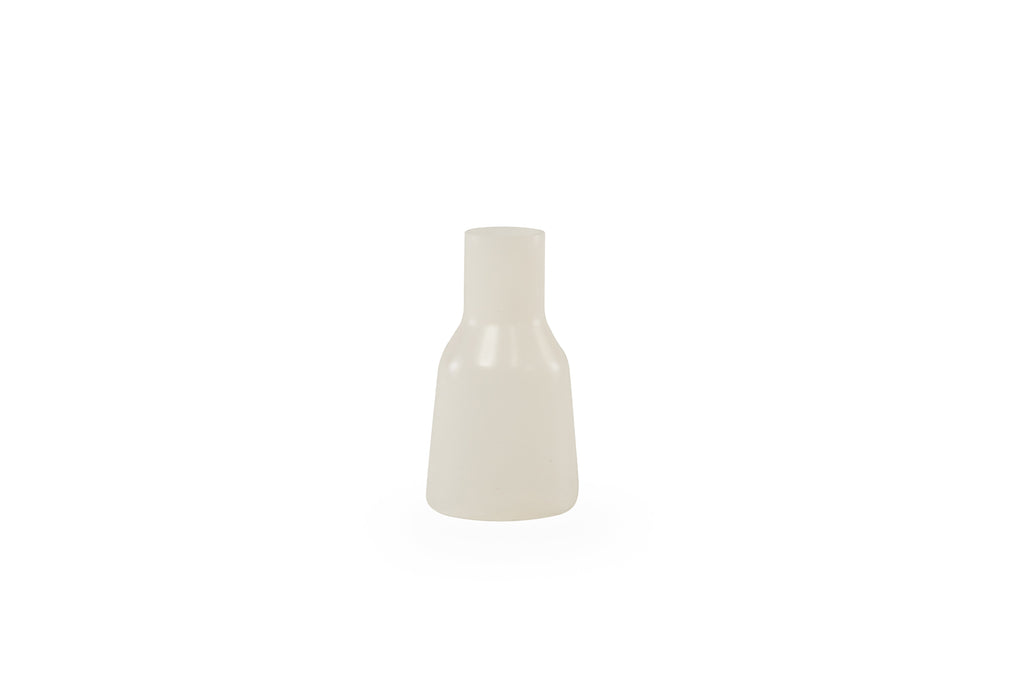
The TUNAIR™ polypropylene Erlenmeyer flask systems are a unique and patented flask and closure system, designed for microbiology and biotechnology applications. This system provides optimum growth conditions for aerobic microorganisms, mammalian cells, and plant cells. It is 25% off for a limited time only!
- Item Description
- Accessories
- Specifications
- Technical Information
Extensive Product Description:
TUNAIR™ flasks provide better culture growth and productivity than standard Erlenmeyer flasks. The TUNAIR™’s high oxygen absorption rate is due to the unique baffling and turbo-vane closure design. The TUNAIR™ systems are designed to increase the availability of dissolved oxygen as well as improve cell yields. The Half-Baffle Shake Flask has two baffles that produce a vortex motion. The working volume is 100 ml.
The flasks are constructed of polypropylene and resistant to most solvents.
All TUNAIR™ flasks can be cleaned by soaking in water with a light detergent solution to loosen contaminants, then air dry. Caps and filters are not included in this product number.
Flask Dimensions:
Flask Size: 300 ml Working Volume: 100 ml Base Diameter: 3.25” [8.25 cm] Neck Diameter: 1.75” [4.45 cm] Height: 6.00” [15.24 cm] Weight: 0.01 lbs. [0.004 Kg]Cell Growth Evaluation of Commonly Used Shake Flasks:
TUNAIR™ flasks were compared to conventional flasks using four different types of microorganisms;Escherichia coli,Saccharomyces cerevisiae, Penicillium avellaneum, and Streptomyces chartreusis. The aeration capacities of the shake flasks were determined by the sulfate oxidation method, and the values shown below are presented as oxygen absorption rate (OAR) in mM oxygen/L/Min. The growth rates of E.coliandS.cerevisiae were expressed as optical densities (OD) at 555 mM. For S.chartreusis and P.avellaneum growth rates were evaluated by percent sedimentation. For E.coli and S.cerevisiae, the growth rates were determined after an 18-hour incubation period; for S.charteusis, a 24-hour incubation period; and for P.avellaneum, a 72-hour incubation period. Growth and OAR evaluations were carried out with 3-9 replicates and statistically analyzed using Turkey’s w-procedure. See results below.
Growth Chart:
| OAR Value | OD @ 555 mM | % Sedimentation | |||
|---|---|---|---|---|---|
| Flask | mM O2/L/Min. | E.coli | S.cerevisiae | S.chartreusis | P.aveilaneum |
| TUNAIR™ Full-Baffle | 4.25 | 7.09 | 5.63 | 19.7 | 3.3 M |
| TUNAIR™ Half-Baffle | 1.22 | 5.36 | 5.57 | 27.73 | 30.50 P |
| Triple Indented Flasks | 2.47 | 5.97 | 5.31 | 19.20 | 9.50 MP |
| Unbaffled Erlenmeyer | 0.52 | 5.97 | 5.19 | 17.37 | 25.10 P |
Growth Morphology:
M, mycelial; P, pellet; MP, mixed mycelial. The mycelial growths mostly adhered to the walls of the flask, which accounted for the low overall sedimentation value.
Growth Comparison of Saccharomyces Cerevisiaein TUNAIR™ Shake Flasks and Brand C Shake Flasks:
The experiment was done on a New Brunswick INNOVA 44 shaker incubator.
It was conducted at different speeds – 200 rpm & 300 rpm.
Strain: Saccharomyces Cerevisiae
Medium: YPD broth (Yeast Extract Peptone Dextrose)
Flasks: IBI TUNAIR™ 300 ml Flask and Brand C 250 ml Growth Flasks
Cell Analyzer: Vi-Cell XR
Experiment Summary:
In this experiment, standard volume--60 & 50 ml YPD--was used for TUNAIR™ and Brand C flasks, which is 20% capacity of the flasks. The flasks were incubated at 30°C at speeds of 200 rpm and 300 rpm for 28 hours. After taking viable cell counts, it was found that under low speed (200 rpm) both TUNAIR™ and Brand C flasks contained yeast cultures of higher cell densities when compared to the higher speed (300 rpm) cell culture flasks.
It was also noted that the TUNAIR™ flask had higher cell density at 200 rpm and 300 rpm when compared to the Brand C flask. Although these data indicate TUNAIR™ flasks support higher density cell growth, we expected that higher speed (rpm) should produce higher cell density due to the higher dissolved oxygen concentration and better dispersion of cells. This unexpected data might be due to frozen cell culture stock, which might take a longer time to adapt to the environment. More experiments are required and are being carried out at this time.
The focus of these experiments will involve:
• Varying shaker speeds and varying volumes of medium
in the TUNAIR™ and Brand C flasks
• Comparative studies between TUNAIR™ 2.5-L growth flasks
and Brand C 2-L flasks
• Varying shaker speeds and varying volumes of medium in the larger TUNAIR (2.5 L) and larger Brand C (2 L) flasks
Reference Papers:
1. Method to Increase the Yield of Eukaryotic Membrane Protein Expression in Saccharomyces Cerevisiae
2. Optimisation of Recombinant Production of Active Human Cardiac SERCA2a ATPase
3. Analysis of Various Bioreactor Configurations for Heavy Metal Removal Using the Fungus Penicillin Ochro-Chloron




